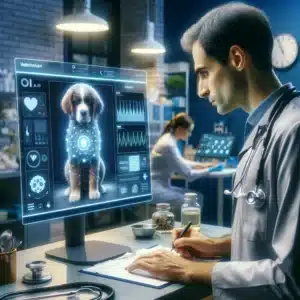 Precision and Partnership: Integrating AI In Veterinary medicine to Optimize Your Practice for Enhanced Animal Care
Precision and Partnership: Integrating AI In Veterinary medicine to Optimize Your Practice for Enhanced Animal Care
It’s nearly impossible to go through a day without engaging with artificial intelligence (AI). From the moment we silence our AI-powered alarm clocks, we’re woven into a tapestry of AI interactions. Whether it’s consulting Gemini for quick facts, using Bing for research, or having a conversation with ChatGPT, AI has become a ubiquitous companion. Beyond these direct interactions, AI subtly orchestrates our experiences, from the GPS guiding our commute to the streaming service that seems to know our music taste better than we do, and even the chatbots that offer customer support with uncanny precision.
The relationship we’ve built with AI is complex. We extend a level of grace to our digital assistants when they falter—when Waze leads us down a peculiar path or when a search engine returns a set of baffling results. After all, these are the growing pains of a technology that’s learning to navigate an ever-changing world. However, the stakes are undeniably higher in fields where precision is not just expected but required. In veterinary medicine, for instance, a deviation from accuracy doesn’t just mean an inconvenience; it could mean life or death.
When AI steps into such critical roles, the margin for error narrows considerably. In the veterinary field, where decisions can have serious, irreversible consequences, the reliance on technology must be measured with a heightened level of scrutiny. It’s not just about whether AI can be used, but how it should be used to support veterinarians in their complex and often urgent decision-making processes.
The journey toward integrating AI into veterinary practice begins with a series of probing questions, not just about the end product, but about its origins, its integration into daily routines, and its capacity for growth and adaptation.
Inquiring into “how it was developed” isn’t just a technical question—it’s foundational. The mechanics of AI, particularly the dataset it was trained on, can tell us much about its reliability and applicability. The “ground truth” of an algorithm is its cornerstone. Was the AI’s foundational dataset compiled by experts in veterinary medicine, ensuring its relevance and accuracy? How dynamic is this dataset? Does it evolve through continuous input from board-certified specialists, or is it static, risking obsolescence?
Furthermore, the dataset’s integrity isn’t the only concern. Ethical considerations must be weighed. Are the training data sourced responsibly? Is patient privacy upheld? As AI learns from its data, the veterinary community must ensure that the data reflects the diversity of cases and conditions they will encounter, without compromising the trust of those they serve.
Understanding the implementation process is equally critical. Many AI solutions come as attractive, shiny tools that promise to bolt onto existing systems effortlessly. Yet, without seamless integration into veterinary practices’ electronic medical records, these solutions can become cumbersome, requiring additional steps that disrupt the flow of work. The workflow should be scrutinized end-to-end. Before embracing a new AI in veterinary medicine tool, it’s crucial to understand the nuances of its operation within the context of the clinic. Who will interact with the AI? When will it be consulted? Will it simplify the workflow, or will it introduce new complexities?
As exciting as new technology can be, we must resist the allure of novelty and focus on practicality. The full potential of AI in veterinary medicine hinges not on its promise but on its performance within the intricate dance of a clinic’s day-to-day operations. It’s about ensuring that AI serves as a reliable ally to veterinary professionals, enhancing their expertise rather than complicating their tasks.
Finally, the question of evolution is paramount. The world of veterinary medicine is not static; it is a vibrant, evolving field where new discoveries and practices emerge continually. Can the AI evolve in tandem with the industry it serves? Is it learning from each interaction, becoming more intuitive and more insightful with every case it encounters? Is there a feedback mechanism that allows practitioners to inform its development?
Embracing AI in veterinary medicine is a journey of continuous collaboration between developers and practitioners. It’s a commitment not just to technology but to a shared vision of enhanced animal care. As we chart this path forward, it is the rigorous questioning, the thoughtful integration, and the commitment to evolution that will ensure AI becomes a trusted tool in the veterinary arsenal, augmenting the expertise of veterinarians with the power of machine learning and data analytics. Only then can we harness the full potential of AI, ensuring it becomes an indispensable asset in the noble pursuit of animal health and wellbeing.
-AM

 Precision and Partnership: Integrating AI In Veterinary medicine to Optimize Your Practice for Enhanced Animal Care
Precision and Partnership: Integrating AI In Veterinary medicine to Optimize Your Practice for Enhanced Animal Care